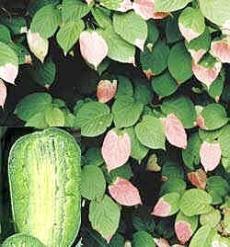

Rare, Hardy, and Unique Plants II


| Hardy Orange Trifoliate Orange (Poncirus trifoliata) is a member of the family Rutaceae, closely related to Citrus, and sometimes included in that genus, being sufficiently closely related to allow it to be used as a rootstock for Citrus. It differs from Citrus in having deciduous, compound leaves, and pubescent (downy) fruit. It is native to northern China and Korea. The fruits are green, ripening to yellow, and 1.5-2" in diameter, resembling a small orange, but with a finely downy surface. It can grow 8 to 15' in height and 6 to 12' in width. They are very bitter, not edible fresh, but can be made into marmalade; and when dried and powdered, they can be used as a condiment. I also have these growing on my property. |
| Pawpaw Tree The Pawpaws are shrubs or small trees, reaching heights of 15 to 30 feet tall. The northern, cold-tolerant common pawpaw (Asimina triloba) is deciduous. The fruit is a large edible berry, 5 to 16 cm long and 3 to 7 cm broad, weighing from 20 to 500 g, with numerous seeds; it is green when unripe, maturing to yellow or brown. It has a flavor somewhat similar to both banana and mango, varying significantly by cultivar, and has more protein than most fruits. The earliest documentation of Pawpaws is in the 1541 report of the de Soto expedition, who found Native Americans cultivating it east of the Mississippi River. The Lewis and Clark Expedition depended and sometimes subsisted on Pawpaws during their travels. Chilled pawpaw fruit was a favorite dessert of George Washington, and Thomas Jefferson was certainly familiar with it as he planted it at Monticello. |



| Hardy Kiwi A small, green to purple skinned, fruit similar to kiwifruit, hardy kiwifruit is an edible, berry-sized fruit of a Cultivar Group of the woody vine Actinidia arguta. Often sweeter than the kiwifruit, hardy kiwifruit can be eaten whole and need not be peeled. Thin-walled, its exterior is smooth and leathery, providing a deceiving contrast to the fuzzy, brown exterior of its larger sibling fruits. The fast-growing, climbing vine is very hardy (hence the name), and is capable of surviving slow temperature drops to -32°C (-25°F). The vines need a frost-free growing season of about 150 days, but are not damaged by late freezes. My vines are in their second season and I am hoping for fruits this year! |
| Issai Hardy Kiwi Self-Pollinating Variety Actinidia Arguta "Issai" Produces enormous yields of fuzzless fruit without a pollinator. Fruits have a juicy texture and tiny seeds like strawberries. Ready to harvest in late Sept. Bears in half the time of other kiwis (by the second or third year). |


| Arctic Beauty Hardy Kiwi Actinidia Arguta "Arctic Beauty" Non-Fuzzy, Eat Like Grapes! You need one female and one male Arctic Beauty Hardy kiwi plants for a bountiful crop of delicious, sweet fruit! Eat these sweet, delicious, bright green kiwis just like grapes-the medium size fruit has smooth skin! May take 7-10 years for them to bear. |
| Michigan State Hardy Kiwi Actinidia Arguta "Michigan State" Everything about this new Kiwi is just a bit better. It's cold-hardier, thriving in the chilly winters of zone 3 without damage. Its fruits are much larger, reaching up to 10 ounces and boasting an unusually blocky shape and lime-green color. It is very productive, guaranteeing you a harvest of at least 100 pounds each year. These plants reach 15 to 20 feet high. Harvest it in fall, beginning just 2 to 4 years after planting. |
